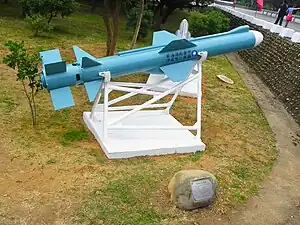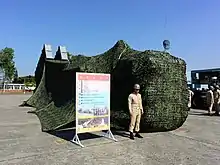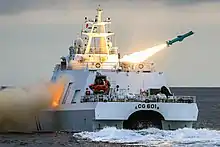Hsiung Feng II
The Hsiung Feng II (HF-2; Chinese: 雄風二型; pinyin: Xióngfēng èr xíng, "Brave Wind II") is an anti-ship missile system developed by the National Chung-Shan Institute of Science and Technology (NCSIST) in Taiwan. The HF-2 is designed to be deployed aboard ships or at facilities on land. An airborne version has also been developed which can be carried by the ROC Air Force's F-CK fighters. The HF-2 has ECCM capabilities and is deployed on the ROC Navy's Cheng Kung-class and La Fayette-class frigates, as well as at several land-based sites. In 2000, plans were announced to replace the HF-2 missiles stationed on the Cheng Kung frigates with the RGM-84 Harpoon, but the budget for this was cancelled.
| Hsiung Feng II 雄風二型 | |
|---|---|
 Hsiung Feng II Anti-Ship Missile Display in Chengkungling. | |
| Type | Surface-to-surface missile |
| Place of origin | Taiwan |
| Service history | |
| In service | Early 1990s-present |
| Used by | Republic of China Armed Forces |
| Production history | |
| Designer | National Chung-Shan Institute of Science and Technology |
| Variants | Air launched version without first stage rocket booster |
| Specifications | |
| Mass | 685 kg (1,510 lb) |
| Length | 4,800 mm (190 in) |
| Diameter | 400 mm (16 in) |
| Warhead weight | 180 kg (400 lb) |
Operational range | 160 km (99 mi) (Block 1) 250 km (160 mi) (Block 2) |
| Maximum speed | 1,041 km/h (647 mph) |
Guidance system | Inertial guidance midflight, terminal with dual active radar homing and infrared homing seekers |
Launch platform | Box launcher or aircraft |
| References | |



Versions
There are three major versions of HF-2 in service. The first to enter service is the ship-based HF-2, with 2 twin box launcher on destroyer DD-915 first as a trial vessel. Later all major surface combatant in RoCN, except the Knox, were equipped with 2 quad-launchers, plus the 7 World War II-era Gearing-class guided missile destroyers that was upgraded to WC3 standard, from the late 1980s to mid-1990s, had added a 1 quad-launcher by mid-1990s to give those air defense ships an anti-surface ability.
An air-launched version appeared in the early 1990s. Carried by two AT-3B trainer/attacker and a single A-3 attacker, the small force poses little threat to the marine intruders due to its small quantity. However, the recent upgraded IDF (F-CK-1C/D) will add the capacity to carry and launch the HF-2, thus greatly enhance the air-to-surface capacity of RoCAF in future. The air launcher version of HF-2 carried by AT-3 is different from the one supposed carried by original IDF (F-CK-1A/B) prototype, due to differences in length of the HF-2 missile (better known as HF-2 Mark 3 and Mark 4), where the rocket designed for one aircraft cannot fit on another aircraft. Unknown if air-launched HF-2 program is continuing at this point.
The land-launch version of the HF-2 is the most secretive one because of its relation with the land-attack version of HF-2E. Fixed base versions were produced first, and all major outlying islands of Taiwan were equipped with fortified HF-2 bases in the late 1990s, replacing old HF-1 bases. Fixed HF-1 bases in the main island were also being replaced with fixed HF-2 launchers, again in fortified positions.
The mobile launcher version was accepted in 2005 and went to mass production in 2006. All mobile launchers, together with mobile command center (with data-link), mobile surface search radar and portable electric generators, were kept in harden shelters and being driven out when needed. The HF-2 mobile launchers, shown in 10 October 2007 parade, was designed to be able to carry both HF-2 and the new HF-3 AShM, by leaving room for the larger HF-3 missile boxes. Same was done to the Oliver Hazard Perry/Cheng Kung-class frigate's new HF-2 launchers after each frigate's major overhaul, starting 2001, that allows the launcher to carry larger HF-3 AShM, besides HF-2. The Ching Chiang-class patrol ships (total 12 built) also are undergoing the same upgrade to carry two twin-mounted HF-2/3 anti-ship missiles. The Kuang Hua VI-class missile boats (total 31 built) carry two twin-mounted HF-2 anti-ship missiles. The Tuo Chiang-class corvettes also carry four quad-mounted HF-2/HF-3 anti-ship missiles.
A submarine-launched version was planned and designed in the mid-1990s, but nothing more was heard.
Block II
In late 2014, CSIST reportedly began the test-launching stage of an extended-range version of the HF-2, increasing range from 160 km (99 mi) to 250 km (160 mi);[1] the range increase was successfully achieved by February 2017.[2]
In 2019 mass production of an improved Block IIB was approved with production to be completed by 2023.[3]
Future development

HF-2B
In November 2019 NCSIST tested a new short range anti-ship missile which while weighting significantly less than the Hsiung Feng II is said to have the same range. The test was conducted using NCSIST’s Glorious Star test ship.[4] The provisional designation is HF-2B and production is scheduled to begin in 2021. The reported range of the HF-2B is 250km.[5]
General characteristics
- Primary function: Anti-ship missile, some prototypes land attack cruise missiles
- Power plant: Solid propellant booster, turbojet in-flight
- Range: 160 km (99 mi) (antiship)
- Top speed: Mach 0.85 (1,040 km/h; 647 mph)
- Weight: 685 kg (1,510 lb)
- Length: 4.8 m (16 ft)
- Diameter: 40 cm (16 in)
- Warhead: 180 kg (400 lb) high-explosive warhead plus advanced technology self-forging fragmentation
- Guidance: Inertial guidance midflight, terminal with dual active radar homing and infrared homing seekers
- Date deployed: Early 1990s
Popular culture
In 2019 Sputnik News and other began propagating a conspiracy theory that the Argentinian submarine ARA San Juan had been sunk by a Taiwanese HF-2 anti-ship missile used by international mercenaries working for multinational oil companies.[6]
References
- Taiwan Navy Accepts New Catamaran - Defensenews.com, 31 December 2014
- Taiwan to upgrade indigenous missile capabilities - Defensenews.com, 6 February 2017
- Phipps, Gavin. "Taiwan to upgrade Hsiung Feng II Block II anti-ship missile". janes.com. Janes. Retrieved 27 May 2019.
- Lao, George (27 November 2019). "Taiwan tests new anti-ship missile". www.taiwannews.com.tw. Taiwan News. Retrieved 6 December 2019.
- Strong, Matthew (2 January 2020). "Taiwan military to produce Hsiung Feng II B anti-ship missile in 2021". www.taiwannews.com.tw. Taiwan News. Retrieved 19 December 2020.
- Deaeth, Duncan (19 March 2019). "Taiwan's NCSIST rejects claim missile sank Argentina submarine". taiwannews.com.tw. Taiwan News. Retrieved 27 May 2019.
External links
- Manufacturer's video:
- Taiwan primer
- GlobalSecurity article on the HF-2